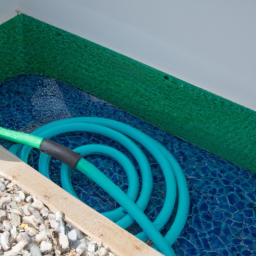Draining an Inground Pool How-To with Garden Hose
Table of Contents []
How To Drain Inground Pool With Garden Hose
Introduction
Learning how to drain an inground pool with a garden hose is a useful skill for any homeowner. Draining an inground pool is a task that can take quite a bit of time. By preparing the pool correctly, and learning about the process beforehand, homeowners can reduce the amount of time it takes them to complete the task. In this article, we will provide an in-depth look at how to drain an inground pool with a garden hose, as well as popular subtopics including setting up the garden hose, preparing the pool, and increasing hosing efficiency.
Setting Up the Garden Hose
The first step for draining an inground pool with a garden hose is setting up the garden hose. You will need to ensure the garden hose can reach the low point drain at the bottom of the pool. This can sometimes be difficult depending on the size of the pool and length of the garden hose. If the garden hose is not long enough to reach the low point drain, you may need to use multiple hoses. For this task, it is best to use two garden hoses that are at least 50-feet long. Attach the two hoses is by using a hose coupler. A hose coupler is a device that is used to connect two hoses together. It is important to check that the hose coupler is sized appropriately and that it can fit both the hoses that you are using.
Preparing the Pool
Once the garden hose is set up, you should prepare the pool for draining. This entails cleaning the pool, emptying the skimmer baskets, and backwashing the filter. All of these steps are necessary to ensure the pool drains quickly and efficiently. Begin by using a skimming net or vacuum cleaner to remove debris from the pools surface. Remove any large leaves and twigs from the walls and floor of the pool, as these can inhibit water flow. You should also empty the skimmer baskets and backwash the filter at least every two weeks. Backwashing the filter helps flush out debris that has built up in the filter, which can lead to an inefficient draining process.
Increasing Hosing Efficiency
The last step for draining an inground pool with a garden hose is increasing hosing efficiency. This entails adding a higher gauge, swiveling elbow, and a tile clamp. A higher gauge, swiveling elbow is a device that screws onto the end of the garden hose and increases water pressure. This can result in a more efficient draining process. A tile clamp is a clamp-like device that attaches to the original garden hose and tile. It helps keep the tile and hose in place, so that they do not loosen while you are draining water. Attaching a tile clamp will insure that the entire draining process is as efficient as possible.
Summary
Draining an inground pool is a task that every homeowner should know how to do. It is important to prepare the pool correctly and to set up the garden hose efficiently. This includes using two garden hoses if necessary and attaching a higher gauge swiveling elbow and tile clamp onto the garden hose for best results. After following these steps, the pool should be able to drain quickly and efficiently.

Previous Page
Next Page
